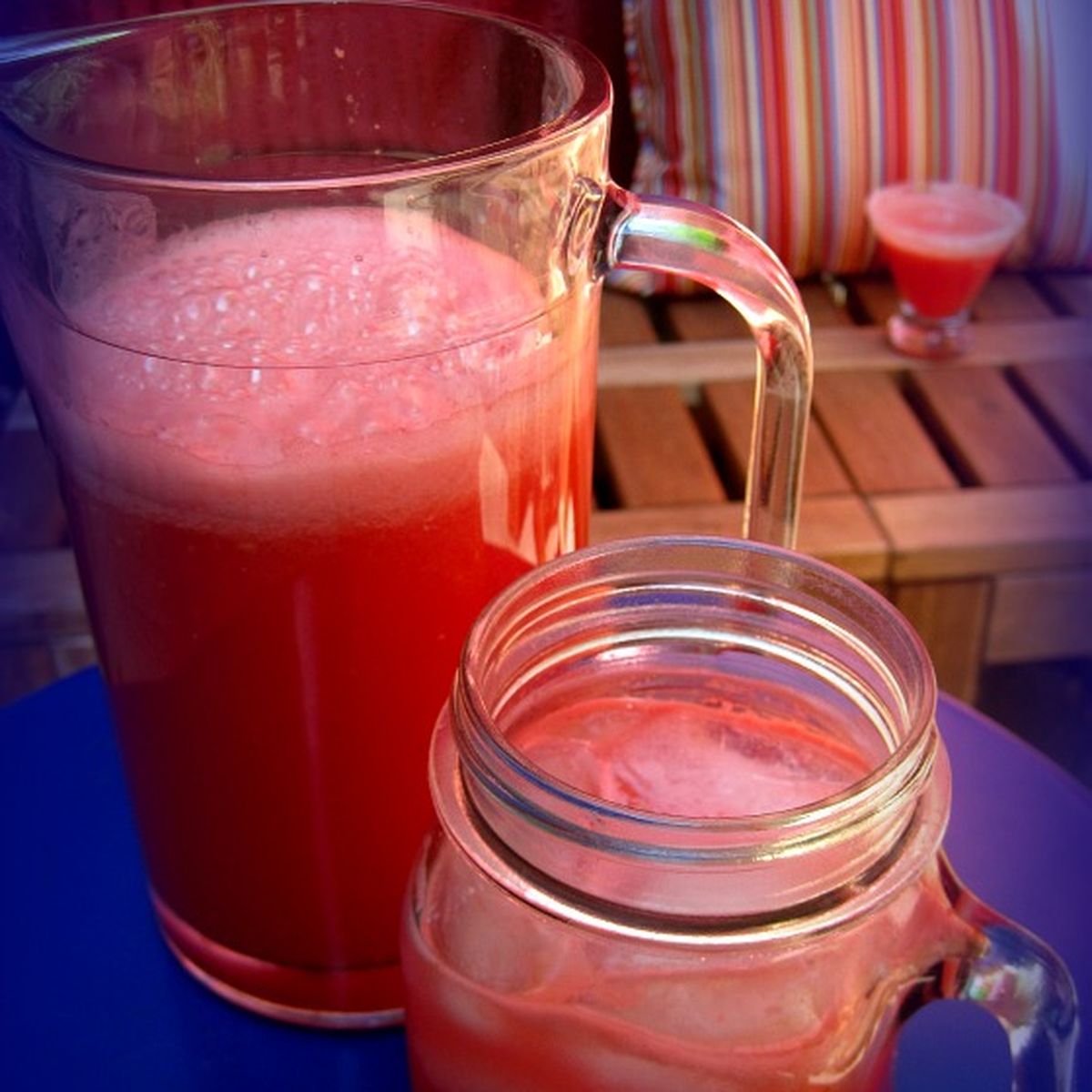Mexican Recipes
504 recipes found

Watermelon Margaritas
What do you do with all that leftover watermelon once the kiddies are snug in bed?? Make Margaritas! Specifically this Jose Cuervo Silver Margarita recipe.

Diana Kennedy's Carnitas
The magic of pork + water + salt -- a genius recipe from The Cuisines of Mexico by Diana Kennedy.

Mexican Market Float
We love all the wonderful flavors of soda we find at the Mexican markets in our area and Jarritos is our favorite brand. Used to be we only saw these unusual flavors available in old fashioned glass bottles at restaurants. My son likes Tamarindo (tamarind) and I've decided to take it to the next level by using it in a float. (Photo found at Walmart.com)

Crunchy Ground Beef Tacos
These tacos are your basic crunchy goodness. I serve them simply with lettuce, grated cheddar and Tabasco sauce. I like these with just a bit of beef, but you can use a bit more if you like beefier tacos. Just keep your oil hot so your tortilla gets crunchy.

Buñuelos
Buñuelos have always been a staple at our family gatherings- perfectly crispy and dusted with cinnamon sugar. Try this Harina Preparada recipe. Enjoy!

Buffalo Ranch Chicken Wrap
By putting sharp shredded cheddar on this hot chicken wrap recipe it allows the cheese to melt and mix with the onion and buffalo ranch for a spectacular taste.

Chicken Quesadillas With Avocado-Cucumber Salsa
There is one caveat when using leftover grilled meat. As the meat chills, the flavors recede, becoming quieter and mellower. For these quesadillas that I made out of Sunday’s grilled chicken thighs, shredded and stuffed into a corn tortilla with a little cheese and quickly toasted, I stirred together a lime-zest-imbued cucumber and avocado salsa that added a welcome citrus edge.

Salsa Verde
Danny Mena, the Mexico City native who is a chef at Hecho en Dumbo, described a good salsa as being “poignant” with heat when he spoke with Julia Moskin in 2010. This recipe for his salsa verde employs a good number of chiles — anywhere between eight and 12 — alongside a couple of pounds of tangy tomatillos. Ms. Moskin described it as “a rounded, tomatillo-based trickle of concentrated flavor with Serrano chiles.” This cooked sauce is ready quickly, and just as good as a table sauce as it is in a larger main, like chilaquiles.

Lemon Lime Margaritas
This lemon-lime margarita recipe uses less tequila and more Cointreau than the standard margarita which made us think the drink might be sweet, but it's not.

michelada del fuego
Have a bowl of chile con queso standing by to quench the fire of this spicy tomato and beer cocktail. The Mexican classic is like a bloody mary with a kick.

Margaritas for Jerks
Let's not pretend; this recipe is for a margarita. With an emphasis on simplicity and taste. Our friend with Mexican-Wisconsin heritage threw these together at a backyard cookout one afternoon and it was a bit like watching a card trick. I can't find a reason to make a margarita any other way. It's a foolproof method and really quick; critical after three or four batches. Note: consider using good beer (we used Goose Island Matilda, a Belgian-style ale ) and great tequila (we used Don Julio). Read on.

Easy Huevos Rancheros
Fried eggs on warm corn tortillas, topped with cooked tomato salsa — it’s a classic dish, though I probably make it a little differently than they do at your neighborhood Tex-Mex restaurant. This recipe makes for an easy supper or a great Mexican breakfast.

Soft Tacos With Chicken and Tomato-Corn Salsa
Tomato-corn salsa is substantial, almost like a salad. These light, fresh tacos make a wonderful summer meal.

Mexican Chicken Soup With Chick Peas, Avocado and Chipotles
This is inspired by a traditional Mexican soup called sopa tlalpeño. The chipotles, added shortly before serving, infuse the soup with a smoky, picante flavor. Cook the chicken breasts a day ahead, and use the broth for the soup. Once the chicken is cooked, the soup is quickly thrown together.

Soft Tacos With Scrambled Tofu and Tomatoes
Soft tofu makes a wonderful stand-in for scrambled eggs. Serve these savory tacos for a great Mexican and vegan breakfast.

Fish Tacos
Fish tacos, that great meal of the Baja Peninsula, and a taste of summer. They are simple to make, no more complicated in fact than a hamburger or a mess of pancakes, and they are considerably more flavorful. Fried in strips and served onboard warm corn tortillas with a simple salsa, a pinch of fresh cabbage, plenty of lime and a cream sauce you might want to punch up with some chopped chipotle, these fish tacos can turn a cold night into bluebird summer, transporting you from chill into deep humidity and bliss. Why You Should Trust This Recipe Sam Sifton, the founding editor of New York Times Cooking and an avid fisherman, created this version of fish tacos after spending time with a chef who specializes in fish. Sam also took inspiration for this dish from the delicious version at El Siete Mares on Sunset Boulevard in Los Angeles before it closed in 2020.

Green Pipian
This classic Mexican pumpkin seed sauce, also known as green mole, is tangy, herbal and spicy all at the same time. Serve it with poached or pan-cooked chicken breasts, fish (it’s very pretty with salmon), or shrimp. You can bathe grilled vegetables with it, or serve it with white beans and steamed or poached vegetables. Hulled untoasted pumpkin seeds are available in many whole foods stores and Mexican markets.

Mark Bittman's Tomatillo Salsa

Wild Mushroom Quesadillas
You don't have to use wild mushrooms, of course, but if you can get chanterelles — oh man. It takes a bit of time at the stove, but when the quesadilla is done, you have a great handheld food that is, among other things, very kid friendly.

Sangrita

Migas With Tortillas and Beans
This recipe, brought to The Times in 2004 by Karen Olsson as part of a collection of regional recipes published in The New York Times Magazine, comes from Juan in a Million, in East Austin. To best appreciate this Tex-Mex favorite, she writes, “the procedure is as follows: Smear the tortilla with a spoonful of the beans, pile on the migas, followed by a dollop of salsa, and tell your cardiologist to kiss your widening behind.” Follow her advice, or don’t. But do garnish it with a bright salsa fresca or pico de gallo, and enjoy.

Huevos Rancheros in Tortilla Cups

Green Chicken Enchiladas
You could poach chicken breasts for these enchiladas, as Amanda Hesser did when she first published this recipe in The Times in 2002, or you could use store-bought rotisserie chicken. After reading several comments from readers who felt the sauce needed to be doubled, we retested the recipe and agreed. We've updated the amounts accordingly.

Guacamole
This guacamole, adapted from Josefina Howard, the chef at the original Rosa Mexicano restaurant in Manhattan is dead simple. It'a also easily scaled to serve a crowd, which is good, because you'll need a lot of it — even if you're the only one partaking.